Eight huge concrete bunkers, the so-called The flakturme was built during the war in the most important cities of the Third Reich:Berlin, Hamburg and Vienna. The heaviest anti-aircraft guns were mounted at the top of the building. Their barrels were to deter and shoot down American Flying Fortresses and British Lancasters. They turned out to be extremely effective and… indestructible.
Hermann Göring, commander of the German Luftwaffe, promised Hitler that no bomb would fall on Berlin. - My name will be Meier if at least one enemy plane appears over Germany - he declared at the beginning of the war.
Göring should have changed his name, because from May 1940 the British were bombing German territory, and on August 25 they even appeared over Berlin. On that day, 29 bombers bombed residential areas of the German capital. It was the beginning of an unlimited air war, during which both sides:the Germans and the Allies bombed each other's territory, turning both civil and industrial facilities to rubble. The Germans flew over London, Birmingham or Coventry, the English "repaid" with air raids on Berlin, Stuttgart, Bremen, Hamburg and many others. This exchange of blows was to last until the spring of 1945. Berlin was bombed 363 times during the war, and its inhabitants called the sirens "Meier's hunting horn."
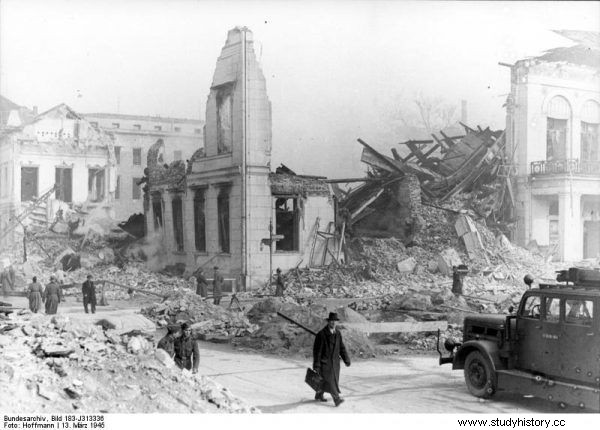
Berlin in March 1945, after Allied air raids
From 1943, when the Allies gained air superiority, bombing became a daily reality and a "nightlife" for the inhabitants of German cities. The Americans - after relocating their Flying Fortresses to Great Britain - bombed the Germans during the day, British planes (including Polish bomber squadrons) threw theirs at night. To this day, there are debates as to whether the strategic bombing of Germany shortened the war and whether it "undermined" the morale of the Germans in any way. Industrial production certainly slowed down, so fewer tanks, guns, and planes left the factories, but did the raids intimidate Hans or Helga into surrender? Let aviation historians or psychologists argue for an answer, and let's get down to earth and visit ... Hitler's indestructible bunkers.
Hitler designs a bunker
The August bombing of Berlin certainly made an impression on Hitler. In September 1940, he ordered the construction of huge bunkers in the city center, which were to be both shelters for the population and - elevated above the city - anti-aircraft platforms . On September 16, Hitler even presented sketches of such towers, and commissioned their construction to Albert Speer, the chief architect of the Third Reich and the Todt Organization, which carried out the largest structural construction investments. The project called the "Special Berlin Program" included the construction of air raid shelters for the public within the Berlin Ring and erection of air raid towers. The city was to have "passive" as well as "combat" shelters, capable of active defense, that is, "biting off" the aggressor. As it turned out later, this "bite off" could be very painful.
It was decided that Berlin will initially build three anti-aircraft towers in three distant districts. The firing from their guns was to create a "pyramid of fire" over the city center, which was primarily to deter, but also destroy Allied bombers. As the towers protruded above the buildings, their guns could fire within a 360o radius. So they could also defend the city borders and shoot bombers approaching the raid. The design of the towers was done personally by Albert Speer and the imaginative architect Friedrich Tamms.
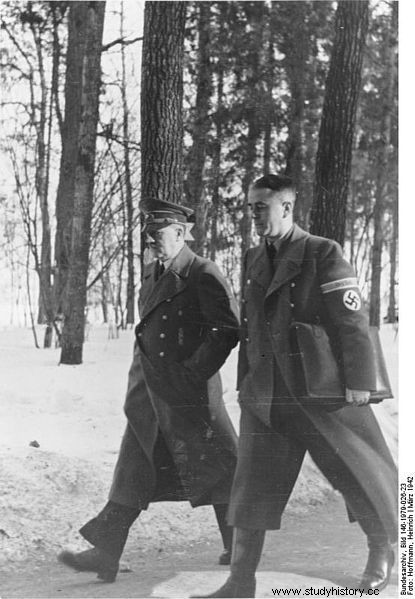
Hitler and Speer as Minister of Armaments and Ammunition (1942)
On Hitler's orders, the "Berlin" program was extended to include two more metropolises:Vienna and Hamburg, considered by him to be the most important cities of the Third Reich. In Berlin and Vienna, they were to defend the city center, and in Hamburg - the port. The project assumed the construction of main turrets armed with heavy anti-aircraft guns as well as several hundred meters away, guide towers, used to control fire and command the anti-aircraft defense of a given district. The towers resembled gloomy medieval castles or prisons, because in each of the corners there were "defensive towers" with powerful cannons at the top.
The bunkers called Flaktürme (the name is a combination of two words:Flugabwehrkanone - anti-aircraft artillery and türme - tower) were built in record time - six months. The G (main) towers had a footprint of 70 × 70 meters and a height of 35 meters. The thickness of the outer walls is 2-2.5 meters, and the roof - on the combat platform - 3.5 meters. This made the structure immune to the impact of almost every bomb used by the RAF at the time . Even in later years, when the size and loadings of the bombs increased significantly, the Flakturm was still "bombproof", especially since a direct hit on the bunker combat platform was very difficult due to its small size.
The British and Americans usually had problems with hitting a factory or a station, so you can imagine the challenge of dropping a bomb precisely on a 70 × 70 meter platform, additionally breathing fire from all barrels. For example, let us say that the tower in Friedrichshain in Berlin was hit by bombs only three times by the end of the war, several anti-aircraft artillery soldiers died, and damaged guns and technical devices were quickly repaired.
The flak towers were armed with excellent anti-aircraft guns. Initially, it was 10.5 cm FlaK 39, which in the summer of 1943 was replaced with an even better and more powerful 12.8 cm FlaK 40. The guns were mounted on the tops of the towers in pairs, two at each of the four corners of the structure. This meant that the tower had eight of the heaviest anti-aircraft guns, as well as a large number (several dozen) of smaller cannons, e.g. single and quadruple 2 cm FlaK 38 and 3.7 cm Flak 43 located below the main battle platform. The towers also had their own anti-aircraft searchlights and huge ammunition stores. Food warehouses, electricity generators and water intakes were located in the underground levels, so they were independent of the city's supplies. The L (guide) towers accompanying the main towers were slightly smaller - 23 × 50 m and were armed not with cannons, but with listening devices and radars, as well as communication and fire control systems.
Ultimately, eight towers were built:three in Berlin, three in Vienna, and two in Hamburg. It was planned to build a dozen or so, incl. one in Bremen and eight in Munich, but the project was not developed due to the enormous cost (estimated cost of one was 24 million Reichmark but actually cost twice as much) and difficulties in obtaining building materials (concrete and steel).
Concrete giants defend the sky
Hitler's idea was realized in a flash. Of course, the most important and priority was the construction of the Berlin towers, which were to defend the skies over the Reich Chancellery and the government district . The tower at the Berlin Zoo was built in six months from October 1940 to April 1941, the tower at Friedrichshain from April to October 1941, and the Humboldthain Flakturm was built from October 1941 to April 1942.
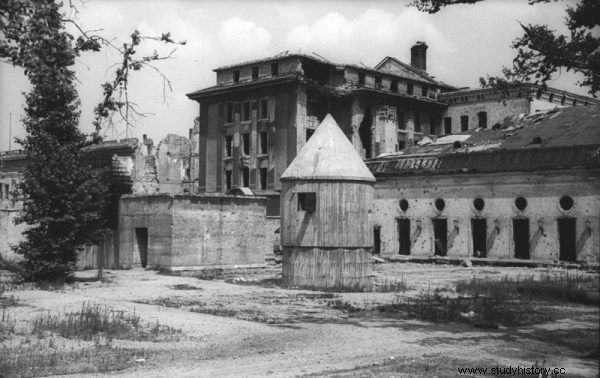
Führerbunker (Chieftain's Bunker) before blowing up
The tower at the zoo was the largest and most interesting. The numbers indicate the size of the investment. For construction:120 thousand. tons of sand, 78 thousand. tons of aggregate, 35 thousand. tons of cement and 9.5 thousand. tons of iron. The Reich Railways supplied 1,600 tons of building materials a day, and a further 400 tons were delivered through rivers and canals. After the war, the British estimated the weight of the tower at 190,000 tons . Over 3,000 workers worked on the construction site, including about 400 prisoners of war and forced laborers. The workflow was personally supervised by Goebbels, Goering and Speer, and Hitler received photos and progress reports at his desk.
Other towers that were built were the towers in Heiligengeistfeld and Wilhelmsburg in Hamburg, which were to defend the port, the city center and the station, and the towers in Vienna:in Stiftskaserne, Augarten and Arenbergpark in Vienna. The towers in Vienna were - according to Hitler's intentions - to defend the historic city center with churches, palaces and museums, and at the same time to be a memento of the Third Reich for the next hundreds of years.
Each of these enormous objects differed slightly in design or number of guns from the others, but the assumptions were similar. The main towers and smaller guide towers were to be resistant to bomb hits of all weights, and at the same time armed with the best and heaviest anti-aircraft guns at that time and additionally supported by the latest technology:radars, beacons, sights and artillery calculators.
During the Allied air raids, the Flakturm fought from start to finish. "Welcomed" the first planes approaching the city, the so-called pathfinders, whose task was to mark the most important targets with incendiary bombs. When the raid was over, the machines that were lagging behind and chased the departing formations fired on. The range of the guns, which was 14 thousand. meters (maximum 17,000), rate of fire 12-15 rounds per minute and an almost inexhaustible ammunition resource, allowing the firing of 8 thousand. rounds per minute (all calibers).
The towers were also a shelter for thousands of inhabitants. During the air raids, they could easily accommodate 15,000 people, but as it turned out later - they could accommodate up to 30,000. In Berlin, due to the "bombproofness" of the towers, the most valuable exhibits from museums and collections were transferred to them. Shielded with thick concrete walls, they were perfectly safe there until the end of the war.
Were Flakturme effective? Certainly so, although it is very difficult to determine how many Allied bombers they shot down. After all, all anti-aircraft artillery batteries stationed in the bombed city were firing during the air raids, and German fighters were also operating outside the city. In any case, the Turmflakabteilung 414 manning the Hamburg Heiligengeistfeld anti-aircraft tower claimed the shooting down of 50 Allied bombers between October 1943 and March 1945. On New Year's Eve of 1943/1944 alone, TFA 441 guns shot down as many as eight American B-17 Flying Fortresses, from On March 7, 1945, the railroad destroyed six British bombers:five Lancasters and one Halifax. The tower was hit twice by bombs, but the damage was minor and the defenses remained intact. The three Berlin flak towers shot down about 65 planes in total, but - as it turned out - they proved themselves not only as strongholds of air defense. They also successfully defended themselves during the Battle of Berlin.
Flakturmy against tanks
In addition to deterring and destroying Allied aircraft, concrete anti-aircraft towers were used for ground combat. At the beginning of April 1945, the Viennese towers proved their worth in this role. The units of the 4th and 9th Guards Army and the 6th Guards Tank Army, conquering Vienna, encountered strong nodes of resistance based on anti-aircraft bunkers. The batteries on the tower in Arenbergpark fired on Soviet tanks for four days straight! The remaining bunkers also defended themselves until the last days of fighting for the city, despite the artillery fire conducted directly into the walls of the building.
The same role was played by the Berlin towers, which fired at ground targets during the Battle of Berlin in the last days of April and the first days of May 1945. The anti-aircraft guns on the upper platform could be lowered -3o below the level, which allowed firing at distant targets located at ground level. On April 21, Flakturmy launched 400 missiles at a group of Soviet armored units in the Marzahn district.
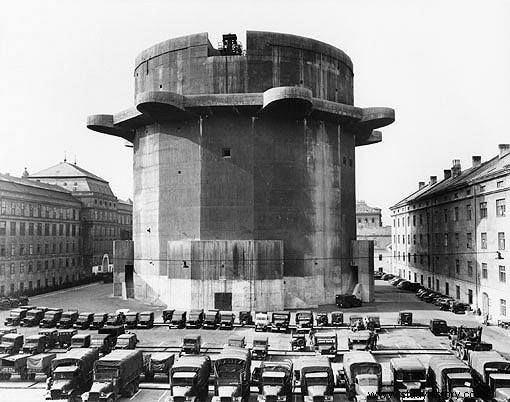
Flakturm Stiftskaserne in Vienna
The ability to defend the towers against ground units was greater than that of other fortified buildings or railway stations. The towers could support each other with fire because they had direct cable and radio communication with each other. Soviet units heading towards the center of Berlin, unable to capture the towers, simply bypassed them. The Russians tried to break the resistance of the giant bunkers, but even the 203mm B-4 howitzers firing straight ahead did little damage to the walls of the building.
Humboldthain's tower crews even launched two local counterattacks. The Soviet reports from the fighting in Berlin contain information on at least a dozen IS-2 tanks destroyed by the main guns of the Flakturmów . Their defenders did not give up for a long time, because they were aware that they were defending not only Berlin and their bunker, but also about 30,000 inhabitants, mainly women, who took refuge in each of the towers.
The towers turned out to be the last points of resistance in the city. Despite the encirclement of Berlin and the control of the entire city by the Russians, the crew of the tower at the Zoo laid down their weapons only on May 2 at 5 am, after receiving a guarantee that the SS and SA soldiers would not be shot. The tower at Friedrichshain surrendered on the same day, which was also the day of the city's surrender. The flakhouse in Humboldthain defended itself for several dozen hours and finally surrendered on May 3 at noon. In the last hours of the fight, the bunker was fired from all sides by tanks and artillery, and snipers sat on the roofs of the nearby buildings. Dantesque scenes took place in the tower. Women from the communications services of the so-called The Blitzmadchen committed suicide by throwing themselves down the stairs, and badly wounded soldiers, senior officers and SS men also took their lives.
Easier to build than destroy
Hitler's monstrous bunkers caused trouble for the Allies also after the war. The decision was made that the Flakturm should be destroyed, especially those built in Berlin. On December 6, 1945, Directive No. 22 was adopted which determined their fate. Preparations for the destruction of the first tower lasted almost a year. Ultimately, the G-Tower at the Zoo was blown up on July 30, 1948, using 30 tons of explosives.
The explosion broke the bunker into three parts, and an earthquake was felt in the vicinity. The British prepared the operation, because Zoo Flakturme was in their zone of occupation. Only in 1952 it was decided to remove the ruins of the destroyed building. The removal of the rubble took three years and ended in 1958. In the place where the tower stood today is ... a hippo enclosure.
A similar fate befell the concrete bunkers in Friedrichshain and Humboldthain. The Russians blew up the Friedrichshain tower twice until it finally collapsed. The debris was buried, which resulted in the creation of a hill popular with Berliners called "Mont Klamott" or "Grosser Bunkerberg". The hill is 78 meters high. One of the walls of the destroyed Flakturm has survived to this day.
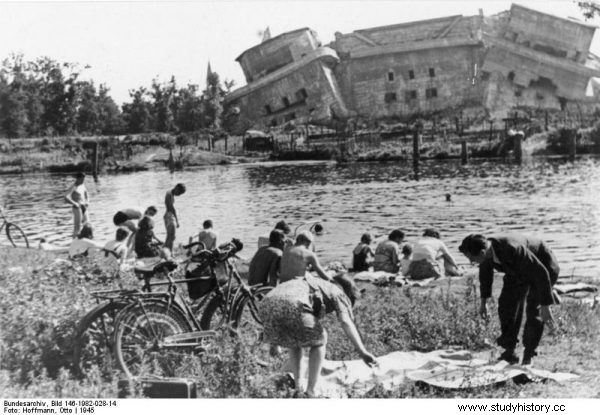
The huge constructions turned out to be very durable
The tower in Humboldthain was destroyed in turn by the French, because it was in their zone of occupation. They blew up the leading tower on December 13, 1947, and the main tower on February 28, 1948. It turned out, however, that some of the buildings had survived, so it was blown up again on March 13. Apparently the French were not good at dealing with explosives because the northern part of the tower has survived to this day . The tower was preserved as a permanent ruin and since 2003, thanks to the activities of the Berlin Underground Association, it can be visited.
The Hamburg flats have survived to our times. Only the smaller leading towers were blown up and dismantled. The towers are mainly used by music clubs, social and cultural organizations . Recently, information appeared in the press that a five-star hotel with 136 rooms and a roof garden will be built in the tower in Heiligengeistfeld. The investor is NH Hotel Group. A night in a room in Flakturma is to cost 100 euro per night.
The anti-aircraft towers in Vienna also survived. They are located in the city center and are a tourist attraction. It is difficult not to pay attention to them while walking, for example, on the Prater. Some of them are used, others have not yet been found, but there are no plans to destroy them, because it is expensive and dangerous . On the outer wall of the tower leading to the Stiftskaserne in Esterhazypark, there is a climbing wall with climbing routes of various difficulties, and inside there is a very interesting aquarium. Thus, Hitler's concrete bunkers have absolutely peaceful functions today. And it should be so.
